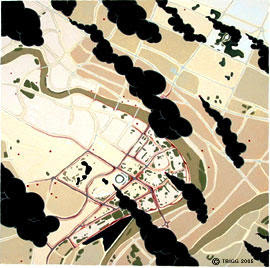 “Some
Economic Tissues” by Sarah Trigg presents a series of paintings which
initiate a dialogue between the visual significance of cartographically
depicted locations, the events which occur in them, and the metaphorical
relationships between events and movements to a biomorphic degree of
symbolic inference. Trigg’s interest in systems is clearly not limited
to the perceived structure of maps and graphs, but also to the
integrative character of organic portent which human relationships and
events of great historical significance occlude when viewed from afar.
The distance of the artist’s chosen perspective specifically dictates
our attention to themes which are imperative to follow. As the artist’s
statement explains:The theme throughout my work is that the selected
sites reveal some sort of socioeconomic activity behaving similarly to
cancerous mutation. By studying man-made tracings and mineralization
(architecture) on the earth's surface, I find the systems that emerge
are biodynamic in nature and that they could be opened up to a
pathogenic analysis. Industrial mines appear as red-cell-producing
spleens; stadium and airports like people-pumping lymph nodes; and
burning oil fields like tissues undergoing cellular mutation. I choose
sites that bear normal functioning tissue and tumor-forming
tissue—cancer cells originate from normal functioning cells but are
unable to healthfully self-terminate. The work developed from this
examination are what I think of as biopsies of a non-linear history.
“Some
Economic Tissues” by Sarah Trigg presents a series of paintings which
initiate a dialogue between the visual significance of cartographically
depicted locations, the events which occur in them, and the metaphorical
relationships between events and movements to a biomorphic degree of
symbolic inference. Trigg’s interest in systems is clearly not limited
to the perceived structure of maps and graphs, but also to the
integrative character of organic portent which human relationships and
events of great historical significance occlude when viewed from afar.
The distance of the artist’s chosen perspective specifically dictates
our attention to themes which are imperative to follow. As the artist’s
statement explains:The theme throughout my work is that the selected
sites reveal some sort of socioeconomic activity behaving similarly to
cancerous mutation. By studying man-made tracings and mineralization
(architecture) on the earth's surface, I find the systems that emerge
are biodynamic in nature and that they could be opened up to a
pathogenic analysis. Industrial mines appear as red-cell-producing
spleens; stadium and airports like people-pumping lymph nodes; and
burning oil fields like tissues undergoing cellular mutation. I choose
sites that bear normal functioning tissue and tumor-forming
tissue—cancer cells originate from normal functioning cells but are
unable to healthfully self-terminate. The work developed from this
examination are what I think of as biopsies of a non-linear history. [Partial statement by the Artist]
 “Some
Economic Tissues” by Sarah Trigg presents a series of paintings which
initiate a dialogue between the visual significance of cartographically
depicted locations, the events which occur in them, and the metaphorical
relationships between events and movements to a biomorphic degree of
symbolic inference. Trigg’s interest in systems is clearly not limited
to the perceived structure of maps and graphs, but also to the
integrative character of organic portent which human relationships and
events of great historical significance occlude when viewed from afar.
The distance of the artist’s chosen perspective specifically dictates
our attention to themes which are imperative to follow. As the artist’s
statement explains:The theme throughout my work is that the selected
sites reveal some sort of socioeconomic activity behaving similarly to
cancerous mutation. By studying man-made tracings and mineralization
(architecture) on the earth's surface, I find the systems that emerge
are biodynamic in nature and that they could be opened up to a
pathogenic analysis. Industrial mines appear as red-cell-producing
spleens; stadium and airports like people-pumping lymph nodes; and
burning oil fields like tissues undergoing cellular mutation. I choose
sites that bear normal functioning tissue and tumor-forming
tissue—cancer cells originate from normal functioning cells but are
unable to healthfully self-terminate. The work developed from this
examination are what I think of as biopsies of a non-linear history. [Partial statement by the Artist]
“Some
Economic Tissues” by Sarah Trigg presents a series of paintings which
initiate a dialogue between the visual significance of cartographically
depicted locations, the events which occur in them, and the metaphorical
relationships between events and movements to a biomorphic degree of
symbolic inference. Trigg’s interest in systems is clearly not limited
to the perceived structure of maps and graphs, but also to the
integrative character of organic portent which human relationships and
events of great historical significance occlude when viewed from afar.
The distance of the artist’s chosen perspective specifically dictates
our attention to themes which are imperative to follow. As the artist’s
statement explains:The theme throughout my work is that the selected
sites reveal some sort of socioeconomic activity behaving similarly to
cancerous mutation. By studying man-made tracings and mineralization
(architecture) on the earth's surface, I find the systems that emerge
are biodynamic in nature and that they could be opened up to a
pathogenic analysis. Industrial mines appear as red-cell-producing
spleens; stadium and airports like people-pumping lymph nodes; and
burning oil fields like tissues undergoing cellular mutation. I choose
sites that bear normal functioning tissue and tumor-forming
tissue—cancer cells originate from normal functioning cells but are
unable to healthfully self-terminate. The work developed from this
examination are what I think of as biopsies of a non-linear history. [Partial statement by the Artist]

Comments